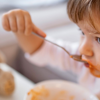It can sometimes be difficult to know where to start when it comes to promoting healthy eating choices for our children.
In this blog, we explore a range of strategies to encourage healthy eating for kids, and how you and your family can eat healthy on a budget in the UK.
Healthy eating for children: helping your child eat a healthy and balanced diet.
'The early years of life is a vital time to set healthy foundations to prevent obesity later in life,' says Talvinder Badhan, Spurgeons' Health Activities Worker. 'Healthy lifestyle intervention at a young age can influence food choices, physical activity levels and leisure activity choices and these are likely to continue into adulthood.'
The Eatwell guide shows the proportions of the main foods and drinks in which different types of foods are needed to have a healthy and well-balanced diet. Ideally, between the ages of 2 and 5 children should gradually move to eating the same foods as the rest of the family, in the proportions shown on the
Healthy eating for families: guidelines
Eatwell guide which should include the following:
-
Fruit and vegetables - protective foods (vitamins and minerals) try to eat at least five portions a day. A portion is a handful – your hand size.
-
Potatoes, bread, rice, pasta, and other starchy carbohydrates – energy foods. Include these at each meal and as some snacks
-
Milk and dairy- strong bones and teeth (calcium) - milk full fat 1–2-year-olds and semi skimmed for over 2s
-
Beans, pulses, fish, eggs, meat, and other proteins - growing food (protein and iron) - Important for growth, repair and maintenance
-
Foods high in fat and/or sugar extra foods (fat and sugar) - these foods are not needed in the diet so should be eaten infrequently and in small amounts.
-
Only offer milk or water and try to avoid sweet sugary drinks which encourage tooth decay.
-
To be careful about salt which can lead to high blood pressure which increases the risk of heart attack or strokes. Maximum daily amount of salt is :1-3 years 2g, 4-6 years 3g, 7-10 years 5g, 11 years 6g, adults 6g

Startwell is an obesity prevention programme running in Birmingham based around 8 key characters and messages to help parents, early years settings and professionals create a healthier environment for our children and families.
To get all the nutrients, they need, it is important for children to have a varied diet containing lots of different foods. Aim for three balanced meals a day and up to two healthy snacks. Use different protein sources in each meal and different varieties of vegetables.
The Startwell characters and their messages
Top strategies to encourage healthy eating for kids
-
Be a good role model for your child and allow your child to see you eating fruit and vegetables. Try and eat together at meal times whenever possible.
-
Talk to them about food and making healthy choices.
-
Create a positive, sociable environment.
-
Never force your child to eat something they do not want to as this could lead to food aversion and negative feelings around food later in life which may lead to eating disorders.
-
Allow them to be messy while using their senses to explore new foods being introduced
-
Presentation is important. Make it fun and visually pleasing to the eye
-
Get them involved with the preparation, washing fruits and vegetables, stirring, mixing, setting the table etc.
-
Shop together and allow them to pick a new fruit or vegetable to try at home each week when shopping together.

-
Always consider portion sizes as children have smaller stomachs then adults and need to eat smaller portions of food regularly. Start by serving up a child size portion on a child size plate and if they really want more than it is okay to offer them seconds. (3 meals a day and 2 snacks.)
-
Take them grocery shopping, have them help mix ingredients together, or have them taste-test along the way. Knowing that they were part of making the food may encourage kids to try the finished product.
-
Consider growing/planting fruits and vegetables outside and keep active.
-
Make mealtimes enjoyable and not just about eating. Sit down and chat about other things.
-
Remember that foods can be offered in a range of ways Changing how you serve a food may make it more appealing eg. roasted, mashed, baked, steamed, grated, stewed, boiled etc.
-
Gradually introduce other foods and keep going back to the foods your child did not like before. Children's tastes change. One day they will hate something, but a month later they may love it. Keep offering a variety of foods – it may take lots of attempts before your child accepts some foods.
-
Try to avoid distractions at mealtimes (TV off, mobile phones switched off, toys put away, radio turned off)
How to eat healthy on a budget
Healthy eating does not always have to be expensive. Eating well for the whole family can be affordable, here are some tips on how how to eat healthy on a budget:
1) Shop around in your local area as prices will vary
Buy frozen fruit and vegetables. These are just as nutritious as fresh and can be more cost effective because you can use what you need and freeze the rest!
2) Look out for promotions on healthy foods or other essential household items
3) Shop in the reduced section
Buy any supermarket brands rather than larger brands. These are cheaper and are often healthier because they have lower levels of salt, fat, and sugar.
4) Buy fruit and vegetables in season
'Stock up on food cupboard items such as plain pasta, rice and dried pulses and lentils e.g., red lentils, chick peas,' says Talvinder. 'Plan for that initial spend or stagger these purchases. These foods will make many meals and last a long time. Pulses and lentils are also cheaper protein alternatives to meat and fish.'
Plan your meals in advance so you know what you need to buy e.g., write a menu for the week. Cooking meals that children will enjoy can prevent food wastage
5) Make a shopping list and stick to it!
Manage “Pester Power” to avoid children asking for lots of unhealthy foods when you go shopping.
Remember that if you are entitled to Healthy Start Vouchers, these can be used to buy milk, fresh, frozen, and tinned fruit and vegetables, fresh, dried, and tinned pulses, and infant formula milk.

How much sugar should a child have a day?
'Each time something sugary is consumed it increases the risk of tooth decay,' says Talvinder. 'Some foods and drinks are obviously high in sugar such as sweets, chocolate, cake, biscuits, fizzy drinks and juice drinks. However, it is also important to look out for hidden sugars especially in foods that seem healthy or are marketed at children such as chocolate cereals, milk shakes, dried fruit, and dried fruit products.'
How much sugar can we eat?
Adults: 30g or 7 cubes
7-10 years: 24g or 6 cubes
4-6 years: 19g or 5 cubes
0-4 years: No guidance limit: avoid sugar sweetened drinks and food with sugar added to it.

Strategies to keep your child’s teeth and gums healthy
-
Support your child to brush their teeth twice a day for 2 minutes (morning time and before bedtime) until they reach the age of 7 for healthy gums and teeth
-
Limit the amount of sugary foods and drinks to avoid tooth decay
-
Bin the bottle and encourage your child to drink from a free flow cup, only offering milk or water.
-
Register your child with a dentist and visit the dentist for regular check-ups as many times as recommended
-
NHS dental treatment is free for all children under 18 or under 19 in full time education.



